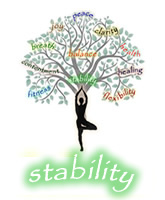The Yoga Sutra tells us that a yoga posture must be stable and comfortable. This is a requirement for a pose to be yoga, rather than just an exercise. There must be a sense of stability, of attention without tension, as well as comfort without slackness.
But this does not happen as soon as we begin to do yoga postures. When we begin to practice postures, we may be unaccustomed to the positions, and strain to move into them. We may even hold the breath. When this happens, there is no stability, just tension, and certainly no comfort.
To achieve stability, we have to recognize and accept our starting place, doing what is appropriate for our body’s condition. We have to learn how to use the breath properly with the posture. We have to learn to be patient with and observant of ourselves, noticing when we are tense or unsteady, or too relaxed, so we can regain our sense of balance and stability.
Our work with stability in postures helps prepare us for other components of yoga, such as breathing practices and meditation. The work in finding the balance of stability and comfort involves the mind as well as the body. The true work of yoga is cultivating a stable mind. The practice of self-observation and stability in yoga postures prepares us to face changes and challenges in our life, helping us to maintain a sense of clarity and centeredness.
